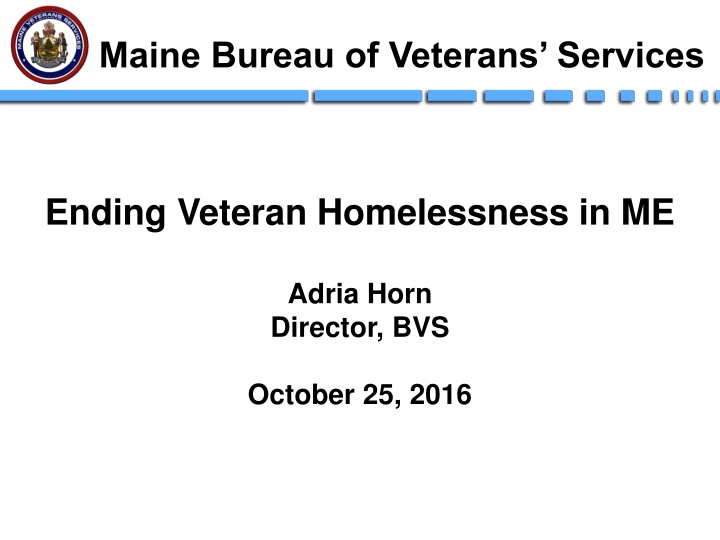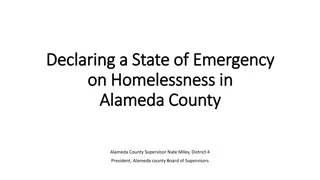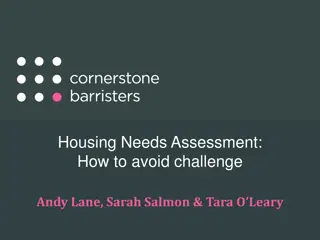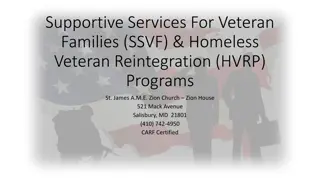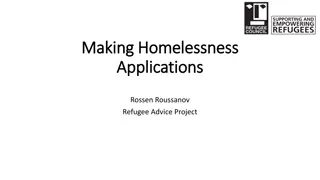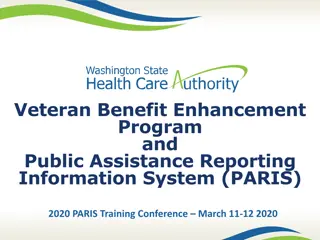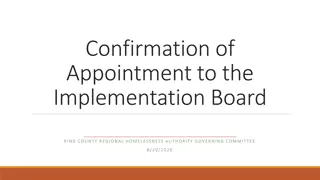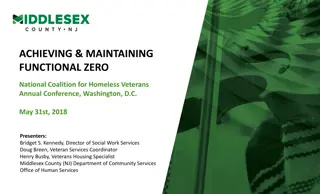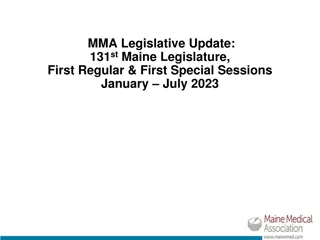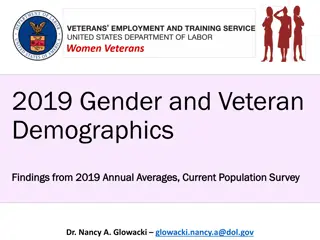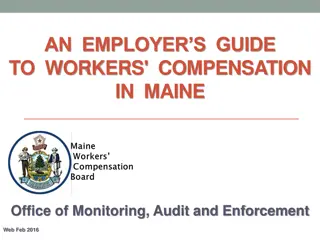Strategies to End Veteran Homelessness in Maine
Providing an update on veteran homelessness activities in Maine, the briefing emphasizes the importance of collaborative efforts across stakeholders and partners. Key tasks include developing a strategic plan, measuring progress, improving communication among service providers, and reporting to the legislature. Despite challenges, there has been a decrease in veteran homelessness in Maine since 2012, highlighting the need for continued efforts and strategic planning.
Download Presentation

Please find below an Image/Link to download the presentation.
The content on the website is provided AS IS for your information and personal use only. It may not be sold, licensed, or shared on other websites without obtaining consent from the author.If you encounter any issues during the download, it is possible that the publisher has removed the file from their server.
You are allowed to download the files provided on this website for personal or commercial use, subject to the condition that they are used lawfully. All files are the property of their respective owners.
The content on the website is provided AS IS for your information and personal use only. It may not be sold, licensed, or shared on other websites without obtaining consent from the author.
E N D
Presentation Transcript
Maine Bureau of Veterans Services Ending Veteran Homelessness in ME Adria Horn Director, BVS October 25, 2016
Purpose The purpose of this briefing is to provide a situational update on the current state of veteran homelessness activities in the State of Maine. This briefing is a fundamental basis to inform strategic planning efforts across the full spectrum of stakeholders and partners throughout the State. Ending veteran homelessness requires assistance by everyone participating and not participating in the Continuums of Care.
Stakeholders & Partners Who else needs to be here? Who else needs to know?
Specified Tasks Develop strategic plan regarding homelessness among veterans. 1) Develop a baseline for homeless in the State from which improvements can be measured. In determining the baseline, the SHC is not required to use the federal definition of homelessness and may include levels of housing instability or ranges of homelessness. 2) Develops a method of measuring homelessness among veterans in the State to demonstrated whether efforts to reduce the number of homeless veterans in the State have been successful 3) Identifies specific processes for improving communication among agencies that provide services to veterans, including services unrelated to homelessness, that will facilitate identification of veterans in need of housing assistance or veterans who may be at risk of homelessness and maximize resources available to address homelessness among veterans 4) Develops a framework and timeline for determining progress of communication and coordination efforts targeting homelessness among veterans and the effectiveness of those efforts in reducing homelessness among veterans Sec. B-4. 30-A MRSA Para 5048, sub para 9
Essential Tasks The Director of the Maine Bureau of Veterans Services shall periodically report to the council regarding the progress of implementing the strategies described in this subsection. Beginning February 1, 2018, the Director shall report annually to the Joint Standing Committee of the Legislature having jurisdiction over veterans affairs on the implementation of the strategic plan. The report must include, but is not limited to, the effect of the strategic plan on homelessness among veterans based on the measurements required to be established by this subsection. *By February 15, 2017, the SHC shall develop an initial Strategic Plan *By March 1, 2017, the Director of the Maine Bureau of Veterans Services shall present the strategic plan [to the Legislature]. Sec. B-5/B-6. 30-A MRSA
Facts 1) Veteran Homelessness in Maine has decreased every year since 2012 2) Federal resources are tied to counts of LITERALLY homeless veterans 3) PIT Annual Survey only counts veterans who self-identify as veterans 4) Non-CoC Groups are not using HMIS or Coordinated Entry 5) Maine organizations getting federal grants to address veteran homeless: Veterans Inc Easter Seals ME Preble Street Bread of Life Ministries VOA 6) State of Maine does not currently provide additional funding specifically for Homeless veterans 7) There are limited family shelters in Maine 8) The are two CoCs in Maine and several organizations contributing to addressing Veteran homelessness that are NOT in either CoC. 9) Portland CoC and MHVAC expects to submit a Mayor s Challenge application to the USICH in November 2016
Assumptions 1) Non CoC groups and stakeholders can participate in HMIS and Coordinated Entry 2) Ending veteran homelessness in Maine is possible 3) Community partnership is required to functionally end veteran homelessness 4) Landlords are not incentivized to participate in ending veteran homelessness 5) Families and female veterans are reluctant to engage in traditional homeless shelters 6) If a veteran is not literally homeless, there are no homeless resources available to him/her 7) Law enforcement, park rangers, and others are potential points of entry to identifying homeless veterans but not engaged enough
Veteran Statistics Maine Grand Total <20 20-24 25-29 30-34 35-39 40-44 45-49 50-54 55-59 60-64 65-69 70-74 75-79 80-84 85+ 127,234 1,395 3,437 4,592 5,368 6,904 8,653 9,361 9,121 9,086 33 11,785 12,536 12,536 19,854 12,571 All Female 10,071 7 175 475 692 825 936 1,054 1,458 1,358 933 600 432 224 378 524 117,163 Male 10,328 11,178 11,604 19,254 12,139 27 1,220 2,962 3,901 4,543 5,968 7,599 9,137 8,742 8,562
2015 Shelter Statistics 46% reduction in veteran homelessness in Maine from 2014 to 2015 90% of homeless veterans are found in Cumberland, Penobscot and Kennebec Counties of which Cumberland County represented 60% of this number 57% decrease in chronically homeless veterans 48% decrease in veterans with disabilities Age Breakdown: 18-30: 10 (5%) 31-45: 53 (26%) 46-64: 129 (64% 65+: 10 (5%) Veteran numbers continued to drop in 2015 (46%). There were 201 homeless veterans accessing shelters in Maine. Both male and female veterans were down significantly.
The vast majority of homeless veterans are located in Cumberland, Penobscot and Kennebec counties. When broken down to unduplicated clients, Cumberland County is identified as having the majority of veterans amongst the top three counties (54%). This also represents a 27% decrease in homeless veterans in Cumberland County.
After a jump in Chronically Homeless veterans from 2012 to 2013, there is still a steady decrease in the number of chronically homeless veterans in Maine from 2014 and 2015. This progress is a direct correlation of veteran initiative programs such as Veterans Affairs Supportive Housing (VASH) and Supportive Services for Veterans Families (SSVF) which provide services to veterans, but also to the most chronic and vulnerable homeless veterans as a whole.
There was a 48% decrease in the number of disabled homeless veterans in Maine from 2014 to 2015. Again, this is likely a direct result of targeting services to both veterans and the most chronic and vulnerable homeless people in general.
Can you/will you come on October 25th to the Augusta Armory from 9 to 3pm for a strategic planning session? Who else needs to be at that planning event? What else does everyone need to know about ending veteran homelessness in Maine? Please inform or correct information on these slides and send to adria.horn@maine.gov
